HYDROGEN PEROXIDE 35%
I finally broke down and bought a small bottle from Rasiel (DOC). I have mixed expectations from this- one part of me thinks that this will work great (it better for the price), while the other part of me thinks it will have little effect or even eat the coins.
I haven't seen any mention of using this through the different sites, groups etc; other than schoolchildren saying "I can see more details". That doesn't really help me. I can make a bath of 5 tblsp of lye to a cup of water (which will quickly eat most anything on the coin, including patina and any "soul" the coin had) and say that I can see more details. Humph! That's why I made this site.
Let's see what it will actually do!
I have 3 different groups, and I'll soak the coins simultaneously in separate containers. Instructions just state to pour enough liquid in a container to cover the coins, and let soak until it's done fizzing. Normal precautions- don't drink, wash liquid off with water yada yada.
2/27/06
GROUP ONE
This group consists of 6 coins which I pulled randomly from my fishtank. I would expect that these would clean the best of the groups- and also have the highest potential of patina loss. Most of the dirt has been removed, and 3 of these probably could be finished with a silver brush. Coins start at 13.4 grams

About 2 hours elasped. I rinsed the coins with tap water, and let air dry.
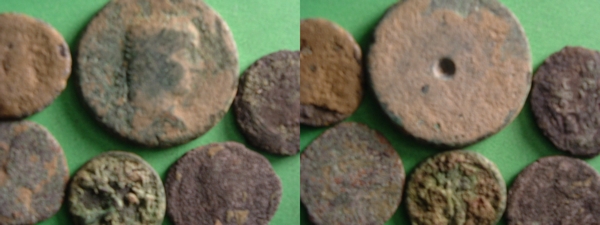
Coins now weigh 13.2 grams, a loss of 0.2. Colors are more vivid and slightly darker. Patinas seem intact. Not much overall difference though. I'm going to use my pin, and see how easily the remaining dirt is removed.
Dirt seems a little easier to remove. It came off as chunks on a couple coins. Encrustation came off somewhat easily in pieces with the titanium straight edge. I spent roughly a minute on each coin; I was able to do more on some than others in this time allotment. I also silver brushed the coins. Patina may have been softened on the larger coin- there's a small circle of patina missing below and to the right of the chin. Because this was under the dirt, I can't prove if it was there to begin with or not.
I spent a couple minutes on each coin- Two are pretty much done. Two (one of the done ones as well) are very porous. Looking at the before pic, it looks like one of them was at least porous to begin with. Dirt obscured the other one. Right now, they weigh 13.1 grams. I'm just going to put them in some solution and let it soak overnight.
After about 24 hours and a toothbrushing, coins weigh 13.1 grams still.
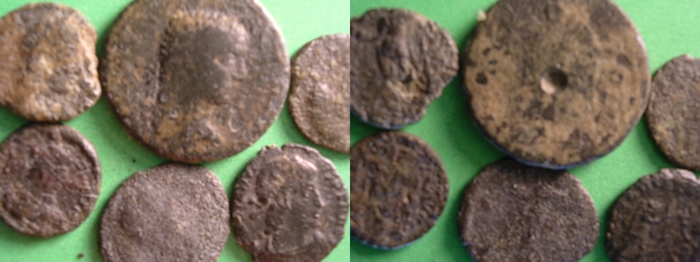
The green patinas, especially on the provincial, seem to have darkened, but the patina seems intact. The lighter patches on the large coin is dirt- not bare metal.
The provincial- I basically gave up on. It's that dirt that even though you scrape a handful of dirt off, it still doesn't seem to have diminished at all. It appears to have silvering on the reverse as well, which complicates matters further. Two of the coins are porous pieces of crap- but no fault of the HP I'm certain. The other coin is somewhere on my floor or in a dog's stomach, it went flying and I can't find it. I believe one of the coins I still need to work on is part of this group as well... there's 2 missing, and I only know where the one went (flying across the room).
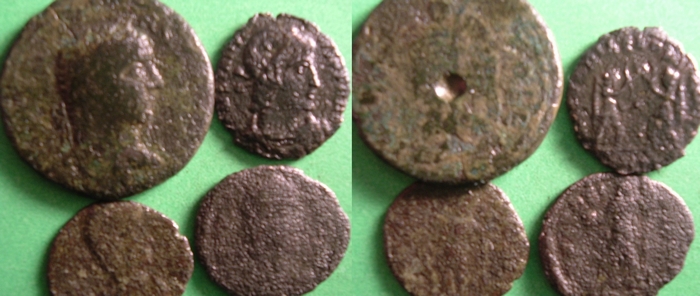
GROUP TWO
These coins are as I received them; they haven't been brushed, soaked etc. Perhaps some light encrustations, but mainly just dirt. Coins start at 6.9 grams.
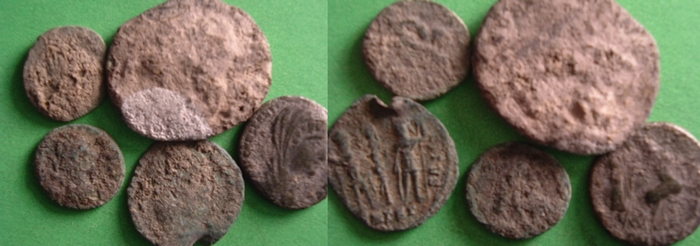
After 24 hours and a toothbrushing, coins weigh 6.8 grams, a loss of 0.1.
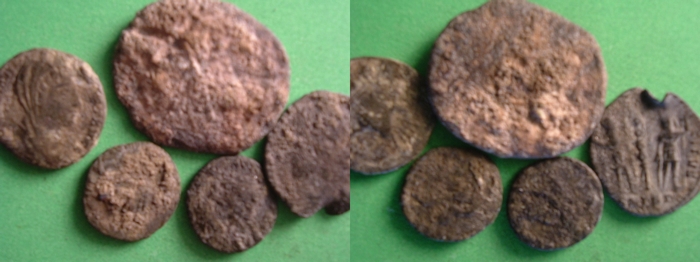
Again, green patinas have darkened... which is not a bad thing for me, since I can't see green very well. I tested a small section on each coin, my Swiss pin melts through the dirt with ease, except for the large coin. There is a nasty green encrustation just below the sand, that is slightly maleable with the titanium straight edge, but it's still cement hard for the most part. The small coins should clean with ease.
The cut gloria exercitvs is being used in the diamond dust experiment, is why it's separate. The ant is still encrusted and soaking in the spent HP, while two of the small coins aren't quite done yet. But here's the posthumous and the Salvs. There are spots of encrustation on the coins still, but I decided to call them done, instead of risking damage to the patina.
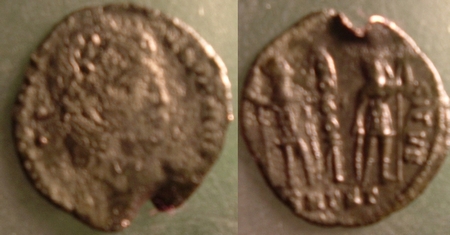
The salvs is actually a beautiful coin in hand, by far the best I have. The picture doesn't do it justice.
Also note, that the green patina has come back on these coins- it is no longer nearly as dark as before.

GROUP THREE
These are heavily encrusted coins that I received from Herb in his ant sized sale last week. These are quite bigger than ants- I think of 30 coins, I received 2 ants and 1 reduced follis- the rest were as/dupondis/ae22+ provincials. Shhh... keep these coins a secret. They're a steal at $1.10 each, even if 1/3 of them look like this. These are untouched as well, and begin at 22.6 grams. The one coin, which is only 75% covered, seems to be a nice provincial with a dark brown/black patina, and fine+ details showing... but it's encrusted from Hades. The thickest part on the totally encrusted coin is 8.9 mm, while the provincial is 8.1mm at its thickest. The coin itself is only 2.15 mm thick... so there is alot of encrustation here.
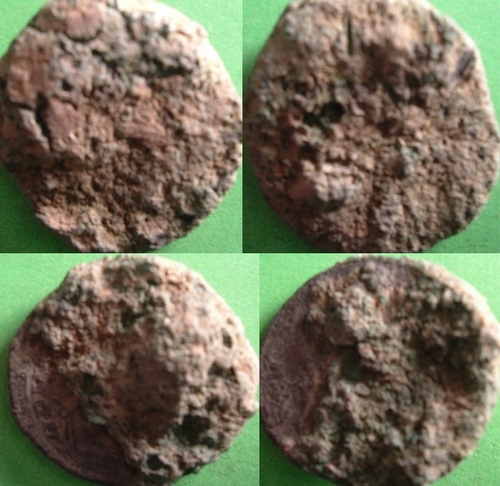
After 24 hours, there was only a loss of 0.2 grams. A bit more can be seen on the bottom coin (above) but not much. I moved the pic around so that you can see that the patina is still intact. Thickest places are 8.7 mm and 8.1 mm. Doing some quick probing with the titanium straight edge, I was able to remove 0.2 grams from the fully encrusted coin, and a whopping 0.5 grams from the coin that shows a little detail. So we are now at 21.7 grams. This is definitely softening up the encrustation and/or weakening the bonds... and patina is still intact.
Just after the brushing- camera battery is dead so can't take an after probe shot-

This seems promising enough that I'm going to buy a mass quantity of it. I spent an hour searching, and was able to find one store that seemed decently priced. I think I spent $8 plus around $5 S/H for this 4 oz bottle- which was only enough for these coins.
After another 24 hours in the pretty much spent HP, the coins still weigh 21.7 grams, but more is visible on the provincial. I worked with the tungsten pin (sorry, thought it was titanium, but it has been tungsten all along) about 1 minute on each side of these coins. I was only able to reduce the weight to 21.6 grams now. The HP is pretty well spent, not much difference, though a bit more of the Provincial is visible.
Patina still intact. Even with revealing new "virgin" surfaces, the old HP barely bubbles. It would seem it's pretty much dead. I'll let these coins soak in it, until my gallon arrives- just to see if anything else happens.
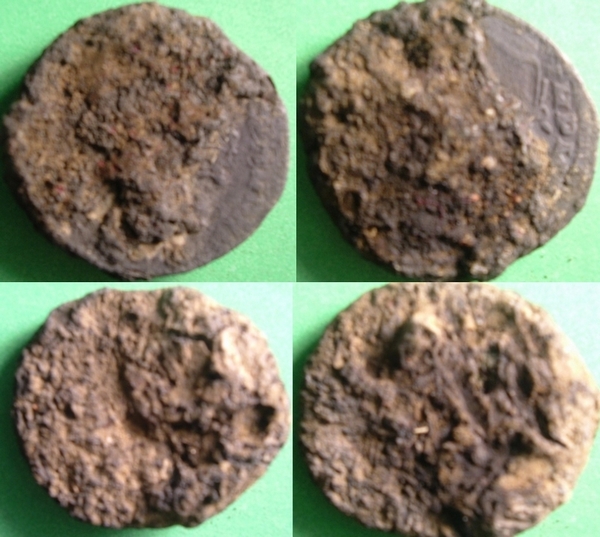
NOTES:
After 3 minutes, all containers are still bubbling vigoursly.
After 5 minutes, still bubbling well, but the two non-encrusted tests have slowed down.
After 15 minutes, the fresh coins are just barely bubbling.
After 30 minutes, the fresh coins (group 2) are just bubbling (1 per 2 seconds or so). Other two groups still bubbling decently. The encrusted group is still almost "boiling"; but nearly as much as it did when it started. Containers are warm, with the encrusted coins' container being perhaps 100 degrees F, group 1 around 90 F, group 2 around 80. House is around 72 F, so the containers really do feel warm, with the encrusted coins almost being hot.
Some kind of gas is being released- if I put a lid on the containers, it soon pops up in the middle. Coins seem to bubble better when air is allowed to contact the solution.
If you get some on your hands, it burns a little bit. Nothing too major, but not quite pleasant either. Looks like it's eating dead skin from my hand. I think that I'll go rinse it off now.
Group one- it seems that I had some sodium carbonate left on the coins. There is about a 4mm layer of "soap" bubbles on top of the solution.
After about 10 minutes, the solution in group 3 is oranish brown, compared to clear.
Loosened dirt particles can easily be seen floating in both groups one and two.
After an hour, group one is ever so slightly bubbling. Group two is still going decently, and the encrusted coins are bubbling more than they were 15 minutes ago.
After an hour and a half, some seems to have evaporated from the encrusted group. I added enough to cover the coins again- and it's happily bubbling away. Group one is about done bubbling. I'll let it go another 10 minutes or so, then add the HP to the encrusted coins.
After 6 hours, groups 2 and 3 are still bubbling away.
Renwax must not be organic- I put a Renwaxed coin into fresh H202 and it didn't even bubble one bubble. After sitting for 5 minutes, some bubbles were attached to the coin... but it certainly isn't fizzing. Update: I put the last 5ml of fresh HP that I tested Renwax in, with the "spent" HP. I threw the Renwaxed coin in with the other coins that I still hagoing. After about 22 hours, the Renwax was removed mostly. It's still adhering to the coin, but can be brushed off. The coin in question is a Byzantine that has BD. I Renwaxed for some reason or other... and wanted to test the HP on BD. Although the Renwax isn't totally removed, the BD has been eaten perhaps 70% away.
It looks like a soak will take 18-24 hours. After 16 hours, I went to bed; they were still fizzing. After 22 hours, they were barely bubbling.
3/17/06
PLEASE READ:
I received my gallon, and have been experimenting with it. This stuff is more potent than what I had previously.
Precautions are necessary with this!
This stuff will burn the dickens out of your skin!!!
Wear gloves/long sleeves if you don't like a bit of pain. It's similar to grabbing a pan out of a 425 degree oven. I used to be a chef before my back became a bed for arthritis- so it's actually a good analogy. It doesn't blister though.
One should wear protective glasses- I was told that a drop in your eye can blind you- and I actually believe this.
Use in a ventilated area- something noxious might be released. I'm not sure on the validity on this- but better safe than sorry.
Do not smoke around it- after all, you are releasing pure oxygen.
Use a small amount, in a small container, on a small amount of coins!!! Perhaps 10 or under ae3's and ae4's, 3-5 larger coins per tub. Susan posted a message about this some time ago on UAC. I already lost the link (sorry Denny)- but of course I HAD to try to duplicate what happened.
I put about 30 coins in a small 4oz container- and filled it with perhaps 2 oz of solution- so the tub was about half full.
It boiled away merrily for 30 minutes or so, then all of a sudden I heard a whoosh. I looked up (I have my ongoing experiments on a shelf on the wall) and the solution was boiling over and a cloud of steam was swirling out of it. This steam had a yellowish cast to it, and smelled a bit nasty. I quickly put the container in a larger quart tub. The container was extremely hot, and the solution was actually boiling. Within about 20 seconds, from the initial whoosh, the solution had boiled itself away, and the coins were bone dry.
SO PLEASE HEED THESE PRECAUTIONS and KEEP AWAY FROM PETS AND CHILDREN
A side note- when the solution starts to fizzle away and not bubble very much, add a dash of 3% hydrogen peroxide. Even if the solution has stopped bubbling entirely, the dash of 3% will enliven it for some reason. It won't bring it back as it was initially, but bubbles quite a bit more than what 3% alone would do.
ANOTHER UPDATE (I posted this on Numistreasures)
I was also able to duplicate the disaster that was reported
on UAC. There seems to be a potential for a disaster if too much metal comes
into contact with the solution. I'm using bronzes, but there are a couple
silver washed coins.
I split the coins that I was testing into 14 small containers last night,
but apparently 4 of them had too many coins. I have one tub with the Theodosius
II campgate alone, and that's been bubbling for 2 days now. Some tubs have
5 As, some have 15 AE3/4, some have 8 AS and two rings... I tried to get a
mix of metal volume between the tubs. I tried to get relatively close with
two of the same volumes, roughly 6 different volumes. I put different amounts
of H2O2 in the similar volume ones... one just covering the coins, the other
with about 1/2oz extra of solution. I'm trying to test if it's the volume
of the metal, or the volume of the solution to metal ratio- that causes the
violent boiling. After 15 minutes or so, the 4 with the most metal started
to boil (not bubble), became super heated, emitted a yellowish plume of smoke
etc. I was ready this time and poured distilled water in them. So apparently-
it's the volume of metal that's in contact with the solution that causes the
chain reaction. So if anyone tries this- they should keep the coins to a minimum-
such as 5 As or 10 ae3/4. I believe that the containers that I'm using are
4oz volume.
Let's run an experiment while I type!
Today, I am diluting the solution- 1/2 H2O2 with 1/2 Distilled water.
I'm going to cut the effectiveness in half I would guess, but at least I shouldn't
have any more boil-ups... and it shouldn't be nearly as caustic as before.
I'll stick my finger in it, and see how it is now...
Hmmm, it made my finger white, but it didn't hurt at all.
I know that I'll catch flak for that experiment lol. But there's only one
way to find out- and I would eventually have accidentally done it anyways.
I already knew what the 35% did (painful- but what's more pain to a person
like me that deals with it 24/7?)... so this isn't too absurd of a test!
Hmmm- even after a minute it doesn't burn at all.
So diluting it seems to have helped on that front. Now to test on some coins...
I have one of the containers that boiled up on me last night, that had too
many coins (some kind of metal threshhold I guess). I'll pour the diluted
solution into it, covering the coins, and let sit. My boilups happened within
seconds of each other last night after approximately 15 minutes, so this step
is going to take awhile...
After 5 minutes, the solution is bubbling happily away- no noticable heat
buildup
After 10 minutes, ditto
After 15 minutes, ditto
After 20 minutes, still bubbling happily, container seems slightly warm- perhaps
a degree or three warmer; or it might be my imagination
After 25 minutes, I think the additional heat was my imagination. Critical
time should have passed by now
After 30 minutes, just bubbling
After 45 minutes, still no heat buildup, just bubbling
I think that the critical mass has been increased with the dilution of the
solution.
Meanwhile, I've been working on my English cull lot. Dirt is coming off easier
than ever. I'm not noticing any patina loss. These English coins; having weak
and partial patinas to begin with, should be the first to show loss of patina
if Hydrogen Peroxide was going to eat it.
I'll test silver when I have a chance- to see if a silver coin (I'll probably
take a worn Roosevelt) has more violent tendencies. I rarely get silver coins
in uncleaned lots, and usually when I do they are those little Arab coins
which can be spotted with ease. Otherwise, they're encased in cement. But
it would be good to know if the H2O2 erupts when using it on silver. I'll
have to wait for a nice day, so I can do that outside.
3/24/06
NOW SOME RESULTS
These coins are a good representative of uncleaned coins in general. Some have soaked in distilled water, while others are fresh as received. Some coins are Balkans, Germanic, Syrian and even English- and everywhere in between.
Basically I grabbed coins and put some into containers at random. Who knows what is from where. I grabbed coins from different spots on the different racks of my fishtank, coins I found on the desk and on the floor, coins in containers that I have no idea why I put them there... just a general mix- so should be a great representation of uncleaned coins.
Unfortunately, I must have deleted the before pictures that I took. Just imagine the general uncleaned coins that you get. Most are pretty well dirt encased, with little or no details showing through... and that's what I started with.
I started these at a 35% HP solution, but when I was able to duplicate the boil over reported by Susan, I switched to 17.5% (35 diluted in half by distilled water); which seems a lot safer to handle. I think 35% was used for 2 days, then the 17.5% for 5 days. I switched solutions once or twice a day, depending if I remembered to change it after work.
I emptied a tub at random, and let them air dry. I grabbed coins at random, and fit as many as I could into a picture. Here's what we have:
A lot of dirt has been removed by soaking in the HP. Very little details were visible, yet many details are visible now. Also, there is always a good amount of dirt in the bottom of the containers when I change the solution.
Now- after a silver brushing. I spent roughly 1 minute on each side with a silver brush. Nothing else was done, no toothbrushing, no picking- nothing but the silver brush.
I'm going to do some work with the pins on these; especially to see if I can even out the top three coins in the above picture. The bent coin is bent so that it's hard for me to grip, and I can't get the silver brush to work well. I'll use a pin on it, then hit it with the 3M radial brush. The real dirty coin- just won't give up its dirt. I'll use the pin on that as well.
But looking at the other coins, which are attributable as they are- this procedure works. A simple silver brushing is all that I have done- from unclean coins with little details, to attributable coins with very little work involved.
No bleaching of patinas, no loss of patinas, and relatively safe to use when reduced to 17.5% HP- I like it!